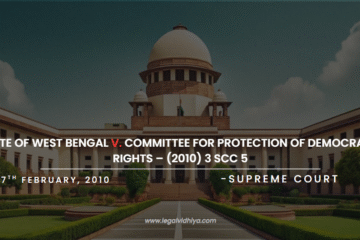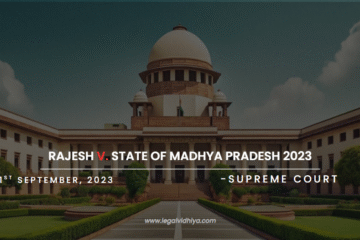
| CITATION | AIR 1957 SC 620 |
| DATE | April 5th, 1957 |
| COURT NAME | The Supreme Court Of India |
| PLAINTIFF/APPELLANT/PETITIONER | Ramji Lal Modi |
| DEFENDANT/RESPONDENT. | State of Uttar Pradesh |
| JUDGES | Chief Justice Sudhi Ranjan Das, Justice Syed Jafer Imam, Justice Sudhanshu Kumar Das, and Justice P. Govinda Menon and Justice A.K. Sarkar. |
INTRODUCTION
The case of Ramjilal Modi v. State of Uttar Pradesh is a landmark judgement concerning the Right to Freedom of Speech and Expression under Article 19(1)(a) of the Indian Constitution and its reasonable restrictions under Article 19(2). The case specifically examined the constitutionality of Section 295-A of the Indian Penal Code, which penalises acts intended to outrage religious sentiments. The petitioner, Ramjilal Modi, was prosecuted under this section for publishing material that allegedly offended religious feelings. The Supreme Court held the validity of Section 295-A IPC, ruling that it constituted a reasonable restriction in the interest of public order.
FACTS OF THE CASE
- Ramjilal Modi was the editor, printer and publisher of a magazine named Gaurakshak, which focused on cow protection. An article published in the magazine allegedly contained statements offensive to the religious sentiments of the Muslim community in Uttar Pradesh. As a result, Modi was charged under section 295-A of the IPC, which criminalises deliberate and malicious acts intended to insult religious beliefs.
- The petitioner challenged the constitutionality of Section 295-A, arguing that it infringed upon his fundamental right to freedom of speech and expression, vested under A. 19(1)(a) of the Constitution of India.
- He also tried to establish that Article 19(2) allows restrictions only on the grounds of public order, morality and security of the state, and that the law was too broad and vague, suppressing legitimate criticism and free expression.
- The state of Uttar Pradesh defended the provision, stating that it was a necessary restriction to maintain public order and communal harmony.
- This case was heard by the Supreme Court of India, where the constitutionality of section 295-A was examined in the context of reasonable restrictions on free speech.
ISSUES OF THE CASE
- Whether Section 295-A IPC violated Article 19(1)(a) of the Indian Constitution by imposing unreasonable restrictions on freedom of speech.
- Whether Section 295-A could be justified as a reasonable restriction under a. 19(2) in the interest of maintaining public order.
JUDGEMENT
- The Hon’ble Supreme Court of India dismissed the petition, stating that Section 295-A of the Indian Penal Code was constitutionally valid.
- The court held that the provision did not impose an unreasonable restriction on free speech but rather targeted only those expressions that were deliberate and malicious with the intent to outrage the religious feeling.
- The court reasoned that such restrictions were necessary to prevent communal disharmony and to maintain the public order as prescribed under A. 19(1)(a).
REASONING
The Supreme Court, in upholding the constitutionality of Section 295-A IPC, provided a detailed interpretation of the reasonable restrictions on free speech under Article 19(2). The Court’s reasoning was based on the following key aspects:
- The Court examined the amended Clause (2) of Article 19, which permits restrictions “in the interests of public order”. Unlike previous cases such as Romesh Thappar v. State of Madras and Brij Bhushan v. State of Delhi, where speech restrictions were struck down for being overly broad, Section 295-A IPC was found to be specifically targeted at acts that could incite violence and disrupt public harmony. The phrase “in the interests of” was interpreted broadly, meaning that even indirect threats to public order justified imposing restrictions.
- The Court distinguished Section 295-A from a blanket restriction on speech. It pointed out that the provision does not criminalise all forms of religious criticism or offensive speech—only those that are made with a deliberate and malicious intent to insult religious beliefs. This ensured that casual, academic, or rational criticisms of religion remained protected under Article 19(1)(a).
- The court emphasised that religious sentiments in India have historically been deeply intertwined with public order. It recognised that deliberate attacks on religion could provoke violent reactions, disrupting societal peace. By penalising only intentional and malicious insults, Section 295-A served a necessary function in maintaining communal harmony.
- The Court examined the legislative history of Section 295-A, highlighting that it was introduced in 1927 following communal disturbances caused by offensive religious writings. The Court referred to previous rulings, including Debi Soren v. State of Bihar, where it was held that laws preventing acts that indirectly affect public order are valid.
- Unlike the laws struck down in earlier cases, Section 295-A was found to be precise and narrowly defined. The court ruled that it did not suffer from vagueness or overbreadth, meaning it could be enforced without infringing upon legitimate free speech.
- The judgement reinforced the principle that freedom of speech is not an absolute right and must be exercised with social responsibility. The Court reasoned that laws protecting religious harmony are necessary in a diverse country like India, where speech that incites religious hatred can lead to serious law and order issues.
CONCLUSION
The Supreme Court’s ruling in Ramji Lal Modi v. State of Uttar Pradesh established a crucial precedent regarding the balance between freedom of speech and reasonable restrictions in the interest of public order. By upholding the constitutionality of Section 295-A IPC, the court reinforced the principle that while free speech is a fundamental right, it is not absolute and can be curtailed to prevent communal disharmony and public disorder. The judgement clarified that the law only penalises deliberate and malicious acts intended to insult religious beliefs, ensuring that it does not unreasonably infringe upon free expression.
This decision has had a lasting impact on Indian jurisprudence, shaping the interpretation of hate speech laws and restrictions on offensive expression. It provided legislative and judicial guidance on draughting and interpreting laws that regulate speech while maintaining constitutional validity. The case remains a significant authority on the scope of Article 19(2) and the necessity of reasonable restrictions to uphold societal harmony and prevent communal tensions.
REFERENCES
- Ramji Lal Modi v. State of Uttar Pradesh, AIR 1957 SC 620.
- The Constitution of India, Article 19(1)(a) and Article 19(2).
- Indian Penal Code, 1860, Section 295-A.
- Romesh Thappar v. State of Madras, AIR 1950 SC 124.
- Indian Kanoon
Written by Ms Somya Upadhyay, an intern under Legal Vidhiya.
Disclaimer: The materials provided herein are intended solely for informational purposes. Accessing or using the site or materials does not establish an attorney-client relationship. The information presented on this site is not to be construed as legal or professional advice, and it should not be relied upon for such purposes or used as a substitute for advice from a licensed attorney in your state. Additionally, the viewpoint presented by the author is personal.
‘Social Media Head’ and ‘Case Analyst’ of Legal Vidhiya.




0 Comments